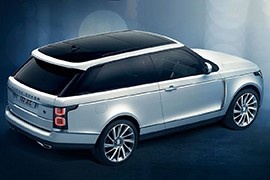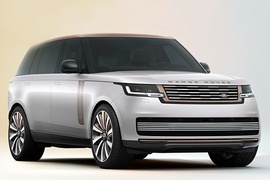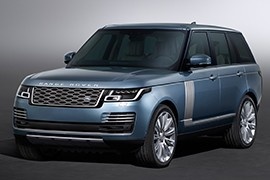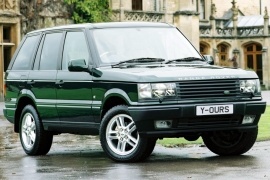
LAND ROVER Range Rover
Generations Timeline, Specs and Pictures

Land Rover unveiled a coupe version of its flagship model, the Range Rover, and promised a limited series that never came.
The Range Rover was built with a three-door bodywork in the first eleven years of production until the carmaker decided to add another two for the rear passengers. Over time, the carmaker built it as a five-door only.
With its massive grille that sported a 3D mesh design, the SV Coupe had a much more aggressive styling than the Range Rover Velar. Its wrapped-around bumper wore another pair of vents on its upper outer corners while a slim aluminum shield peaked under the middle section to remind that the car was still capable outside the paved roads. But the profile offered the most striking difference. The slightly sloped roof and the raked-forward tailgate created the image of a large hatchback.
Inside, Land Rover installed a similar dashboard as the Velar, covered in leather and wood veneers. The carmaker dropped the analog dials and installed a 12” digital instrument panel complimented on the center stack by a 10” infotainment touch-screen. A tall center console separated its leather-wrapped front seats with a storage compartment and the rotary gear selector. The carmaker extended the center console to the rear bench. Thus, it transformed the cabin into a four-seat-only cockpit with individual areas for each occupant.
Under the hood, Land Rover Special Vehicle Operation (SVO) division installed a 5.0-liter supercharged V-8 carried over from the production version but upgraded to 565 hp. The power went in all corners via an eight-speed automatic gearbox. Like any Range Rover before, the car featured a transfer case with high and low range gears. It also sported two locking differentials and a height-adjustable suspension.

After half-of-century on the market, Land Rover’s flagship started its fifth generation with a complete makeover from the ground up.
The Range Rover was the original luxury SUV. It offered image, comfort, luxury, and performance. With the fifth generation, Land Rover transitioned towards the electric-powered Range Rover by implementing hybrid drivetrains, and it was available in a short or long wheelbase.
Designing a luxobarge with a record aerodynamic factor might be useless as long as the overall frontal fascia was that big. Yet, Land Rover engineers struggled and created a 0.30 Cx, helping the big SUV get a better fuel efficiency. Its front fascia with flush headlights and raked grille looked like they were installed on a concept car. Moreover, another appealing factor was the shaved door handles system carried over from its siblings Range Rover Velar and Jaguar F-Type. The ascending beltline and the falling roof design were part of this aerodynamic concept.
Inside, the carmaker used all its resources to create a luxurious environment for four or five occupants. It was available in three trim levels: SE, HSE, and Autobiography. A 13.1” touchscreen display for the infotainment system allowed access to most onboard computer areas, while the driver’s side benefited from a 13.7” TFT instrument panel. Thanks to its luxurious yet sustainable materials used on the interior, the Range Rover SWB showed a high commitment from the carmaker for a cleaner future.
The new MLA platform used by Land Rover allowed the use of a new 4.4-liter twin-turbo V8 powerplant carried over from BMW. In addition, a plug-in hybrid version provided a full-electric range of up to 80 km (50 miles).

The bigger brother of the Land Rover Range Rover featured a long wheelbase for enhanced comfort for the rear passengers.
Just like the S-Class, which was always available with a standard and a long wheelbase, the 2021 Range Rover spoiled its customers with an option for more legroom for the rear passengers. While it kept most features from its SWB sibling, there were a few more unique ones for this super-luxurious SUV.
Thanks to the MLA-flex platform, which allowed more options and amenities, Land Rover created this LWB version of the Range Rover, especially for those who need to spend more time on the roads. And, while on the road, they need to relax or work in this mobile office on wheels. The carmaker offered an option for a four-seat layout and enhanced amenities for the rear passengers, such as a rear screen entertainment system. It featured an 11.4” HD screen with an HDMI socket. Thanks to the onboard wireless system, it could also stream movies and other online content.
To ease the ingress and egress from the luxurious SUV, Land Rover installed a standard air suspension for the car. Moreover, it added power-assisted doors, which helped the passengers open and close them on slopes up to ten degrees.
For the technical side, the Range Rover LWB featured a standard all-wheel steering system. Also, like all its predecessors, the all-wheel drive was standard. Moreover, Land Rover installed a standard electronically-controlled rear locking differential. At the time of its launch in October 2021, the luxobarge SUV featured a twin-turbo 4.4-liter V8 built by BMW. Thus, the carmaker parted away from its traditional 5.0-liter V8. In terms of efficiency and preparing for future enhancements, Land Rover announced a plug-in hybrid version, with elements carried over from its stablemates.

Land Rover refreshed the Range Rover SUV in 2017, adding more luxury, amenities, and bold looks than ever before.
The front end gets a new bumper with revised air intakes, new grilles, and redesigned LED headlights while the back comes with a more robust bumper and new lights. The interior received wider, softer seats, a new infotainment system that combines two 10-inch touchscreens and more amenities like gesture sunblind, cabin air ionisation, and activity key. The engine range has been revised too, including the PHEV variant which now recharges its battery faster.

The fourth generation of Land Rover’s flagship SUV represents a considerable evolution of the previous generation of Range Rover.
It boasts significant technological improvements, more efficient engines, unique character and the first diesel-hybird variant ever.
The biggest headline for the new Range Rover is the chassis, which has been made a light as possible, shedding up to 420 kg (926 lbs) for some models. Aluminum has replaced heavy steel, and the separate chassis construction has been ditched in favor of a monocoque one. This makes the vehicle more efficient and improves the on-road behavior.
All the Range Rovers were equipped with full-time four-wheel-drive and had a Terrain Response Control system to detect the surface to change traction and stability. Different settings were available: General, Grass/Gravel/Snow/Mud/Ruts, Sand and Rock Crawl. The ground clearance was high due to the air suspension.
As for the range of engines, the car was available with a 5.0-liter supercharged V8, a tweaked incarnation of the outgoing model’s 4.4-liter TDV8 diesel, as well as a pumped-up version of the 3.0-liter V6 diesel.
The interior was fitted with standard leather upholstery and an optional panoramic sunroof. As standard, the Range Rover came with dual LCD screens, one of 12.3 inch and the other one with 8-inch touchscreen that ran the infotainment system.

Unveiled at the 2009 New York Auto Show, the Range Rover came with a subtle facelift and the new LR-V8 5.0-liter supercharged petrol engine. The exterior was slightly restyled, with a redesigned front grille and bumper, LED head and tail lights, features that kept the SUV’s traditional lines, but brought a fresh and contemporary feel to its presence. The interior was upgraded as well, the center console was rearranged while a touch screen display with dual view technology was fitted in on the center panel. The driver’s instrument cluster was replaced with a fully configurable 12” TFT screen with virtual dials and information displays. In terms of engines, the 3.6-liter LR-TDV8 diesel engine was retained and the new 5.0-liter supercharged petrol unit was premiered with a power rating of 510 PS and a 7.3 percent fuel consumption reduction. This luxury SUV is now available with Blind Spot Monitoring and surround camera system, while the state-of-the-art Adaptive Dynamics technology ensures top level ride quality.

The Range Rover model line made significant sales by 2005 and despite the fact the company switched hands on several occasions, the cars maintained their sales.
With its success on both sides of the Atlantic, it was time for a new facelift (there were even anniversary and special edition issues made later on). This facelift consisted mainly in exterior modifications. The only thing changed on the inside was under the hood, with the BMW engines being replaced by Ford motors. Now the car had a supercharged versions on all engine types, including on the Jaguar AJ-V8 model which produced some 300 bhp.

The 2002 Land Rover Range Rover was the the most luxurious, exclusive, off-road vehicle on the market and it was the car that could handle well in front of a million dollar estate and in mud terrain.
While the Range Rover was developed under BMW ownership, it was the Ford that took the actual benefits from selling the car around the world. The Range Rover was fit for Her Majesty and for other country rulers, but also completely adequate in front of a luxurious HQ of a big corporation. Some said that it was the true competitor for the Mercedes-Benz S-Classe. And, in some ways, it was.
It’s majestic appearance, with an “in-your-face” straight front fascia, the not-so-raked windshield and the big side windows made the vehicle looks like a British castle on wheels. In the back, the raked-forward windscreen was opened separately by the lower panel, which was opened downwards to create a bench to sit on while in the camping site.
Inside, there was a British luxury feeling with its hand-stitched leather-clad interior and dashboard. The wood-trims were not made from plastic and the metallic-looking door-handles and gear-selector were made from metal, not from plastic. It also offered plenty of room for five, full-grown adults. If needed, the rear bench could have been fold down to expand the big trunk size.
Under the hood, BMW installed 3.0-liter diesel engine before it sold the Land Rover company to Ford. The blue-oval brand was stuck with the German engines until 2006, when it replaced-it with their 3.6-liter V-8 diesel unit. For the gasoline versions, the Range Rover started with the BMW 4.4-liter V-8 used on the X5, but after 2006 Ford installed Jaguar’s 4.2-liter units.

After a quarter of a century of production, Land Rover changed the first generation of the Range Rover to a much better vehicle.
Land Rover didn’t consider changing the model until it was too obvious that the upgrades and facelifts couldn’t improve the car enough to keep up with the competition. After a long debate in their office, the engineering team from Solihull decided to make a new vehicle that resembled the look of its predecessor but improved in any detail.
From the outside, the carmaker dropped the flush door handles and installed regular ones, which were easier to grip and pull, especially with a gloved hand. The front fascia was new and included a broad grille with plastic horizontal slats and big, squared headlights. Its wrapped-around plastic bumpers were modern and improved the drag-coefficient as well. But that was irrelevant for a bus-sized vehicle. The designers kept the slightly raked-forward rear end with a split opening tailgate system where the window was opened upward, and the lower side folded down to make it a bench.
Inside, depending on the trim level, the Range Rover featured cloth or leather seats. A major improvement was for the electrically heated windscreen, which was a unique feature on the market and very useful, especially for the diesel-powered versions.
Under the aluminum body, the carmaker installed live axles both front and rear, with coil-springs all-around. A pneumatic system was fitted as an option later on, and that helped the car get better attack and fording numbers. Land Rover installed an all-wheel-drive system with a locking center differential and a low-range gear.

Launched in 1970 as a three-door version only, the Land Rover Range Rover evolved over time from a simple, utilitarian off-road vehicle to a luxurious one.
In 1988, the Range Rover received a final update for it before it made room for the second generation. After 18 years, it received an additional pair of doors and luxurious items. Another significant improvement was the introduction of the Long-Wheel-Base (LWB) version that added more legroom for the rear-seat passengers. It was already a royal vehicle included in Her Majesty Service.
The final update brought a plastic grille with horizontal slats that replaced the previously used metallic grille. It still used the same round headlights. Its bumper was no longer made from steel. It was a plastic, wrapped-around one, slightly extended downwards.
Inside, the carmaker still offered the Range Rover in a basic trim with little carpeting on the floor and a plastic dashboard. The upper trim levels featured leather upholstery, wood-trims, and leather steering wheel and gear-knob. Land Rover installed an air-conditioning unit to enhance the driver’s comfort and fitted the power-steering as standard.
Under the hood, Land Rover decided to send the carburetors to the dumpster and introduced a fuel-injection system that brought more power and increased the fuel-efficiency. Unlike its predecessors, it featured a chain-driven 4x4 system instead of a simple, transfer-box one.























































